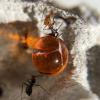- Formiculture.com
- Forums
- Gallery
- Members
- Member Map
- Chat

How to get ants to move?!
Started By
WILLj
, Jan 13 2020 11:48 PM
8 replies to this topic
#1
 Offline
-
Posted January 13 2020 - 11:48 PM
Offline
-
Posted January 13 2020 - 11:48 PM
Hey, I need some advice on trying to get my colony of pheidole to move into a new formicarium. I have to move them into a new formicarium as their old one is due for a clean. I have exposed them to light for nearly 4 hours with the new formicarium hooked up and still they show no signs of moving. I am worried the light may stress the queen out and possibly kill her. Could someone please tell me if that is a possibility and some tips on getting ants to move. Any response would be appreciated, thanks.
#2
 Offline
-
Posted January 14 2020 - 4:48 AM
Offline
-
Posted January 14 2020 - 4:48 AM
With Pheidole, I just dump the colony into the new outworld (if they're in a tube).
My Main Journal | My Neivamyrmex Journal | My Ant Adoption | My YouTube
Join the TennesseeAnts Discord Server! https://discord.gg/JbKwPgs
#3
 Offline
-
Posted January 14 2020 - 6:29 AM
Offline
-
Posted January 14 2020 - 6:29 AM
Yesterday I forced a Tetramorium colony to move by whacking their multi-compartment glass tube until they fell out into the outer compartment, and from there I whacked them until they fell into the tubing. Repeat until most of the brood, workers, and queen were in tubing. Plugged off tubing. Other end of tube was in mini-hearth.
By the way a couple of my queens are under light all day long and doing okay, though the above colony collected enough sand to plaster over the glass.
Formiculture Journals::
Veromessor pergandei, andrei; Novomessor cockerelli
Camponotus fragilis; also separate journal: Camponotus sansabeanus (inactive), vicinus, laevigatus/quercicola
Liometopum occidentale; Prenolepis imparis; Myrmecocystus mexicanus (inactive)
Pogonomyrmex subnitidus and californicus (inactive)
Tetramorium sp.
Termites: Zootermopsis angusticollis
Isopods: A. gestroi, granulatum, kluugi, maculatum, vulgare; C. murina; P. hoffmannseggi, P. haasi, P. ornatus; V. parvus
Spoods: Phidippus sp.
#4
 Offline
-
Posted January 14 2020 - 3:56 PM
Offline
-
Posted January 14 2020 - 3:56 PM
Research. It depends on species. For pheidole in general, expose them to open air. It's usually enough.
#5
 Offline
-
Posted January 14 2020 - 5:17 PM
Offline
-
Posted January 14 2020 - 5:17 PM
The common method is shining an LED or florescent light (one that doesn't significantly heat the tube, which could cook the ants inside) on them, and the ants, being naturally photophobic, just might move into a darker environment. As mentioned, it depends on species, and they may just have to be dumped.
"God made..... all the creatures that move along the ground according to their kinds (including ants). And God saw that it was good. Genesis 1:25 NIV version
Keeping:
Formica cf. pallidefulva, cf. incerta, cf. argentea
Formica cf. aserva, cf. subintegra
Myrmica sp.
Lasius neoniger, brevicornis
#6
 Offline
-
Posted January 15 2020 - 1:19 PM
Offline
-
Posted January 15 2020 - 1:19 PM
Speaking of which I'm trying to force my new Veromessors to move to a new tube from their previous tube. Unfortunately their cotton is a bit of a mess (they were digging in it like crazy and stuff) so they have really good stuff to grip with their feet (so much for whacking), and they don't seem very good at retrieving lost brood, so I'm going to have to try the light therapy on them. Bleh -_-
Formiculture Journals::
Veromessor pergandei, andrei; Novomessor cockerelli
Camponotus fragilis; also separate journal: Camponotus sansabeanus (inactive), vicinus, laevigatus/quercicola
Liometopum occidentale; Prenolepis imparis; Myrmecocystus mexicanus (inactive)
Pogonomyrmex subnitidus and californicus (inactive)
Tetramorium sp.
Termites: Zootermopsis angusticollis
Isopods: A. gestroi, granulatum, kluugi, maculatum, vulgare; C. murina; P. hoffmannseggi, P. haasi, P. ornatus; V. parvus
Spoods: Phidippus sp.
#7
 Offline
-
Posted January 15 2020 - 5:41 PM
Offline
-
Posted January 15 2020 - 5:41 PM
I've had a queen get strangled in cotton strands..... ![]()
"God made..... all the creatures that move along the ground according to their kinds (including ants). And God saw that it was good. Genesis 1:25 NIV version
Keeping:
Formica cf. pallidefulva, cf. incerta, cf. argentea
Formica cf. aserva, cf. subintegra
Myrmica sp.
Lasius neoniger, brevicornis
#8
 Offline
-
Posted January 16 2020 - 3:32 PM
Offline
-
Posted January 16 2020 - 3:32 PM
I've had a queen get strangled in cotton strands.....
Ugh, not surprised. Thankfully she actually moved to the other tube overnight with the egg pile so today I rudely whacked the last holdouts into the new tube and put them back in their outworld.
Formiculture Journals::
Veromessor pergandei, andrei; Novomessor cockerelli
Camponotus fragilis; also separate journal: Camponotus sansabeanus (inactive), vicinus, laevigatus/quercicola
Liometopum occidentale; Prenolepis imparis; Myrmecocystus mexicanus (inactive)
Pogonomyrmex subnitidus and californicus (inactive)
Tetramorium sp.
Termites: Zootermopsis angusticollis
Isopods: A. gestroi, granulatum, kluugi, maculatum, vulgare; C. murina; P. hoffmannseggi, P. haasi, P. ornatus; V. parvus
Spoods: Phidippus sp.
#9
 Offline
-
Posted January 16 2020 - 4:51 PM
Offline
-
Posted January 16 2020 - 4:51 PM
just dump them in
1 user(s) are reading this topic
0 members, 1 guests, 0 anonymous users



















